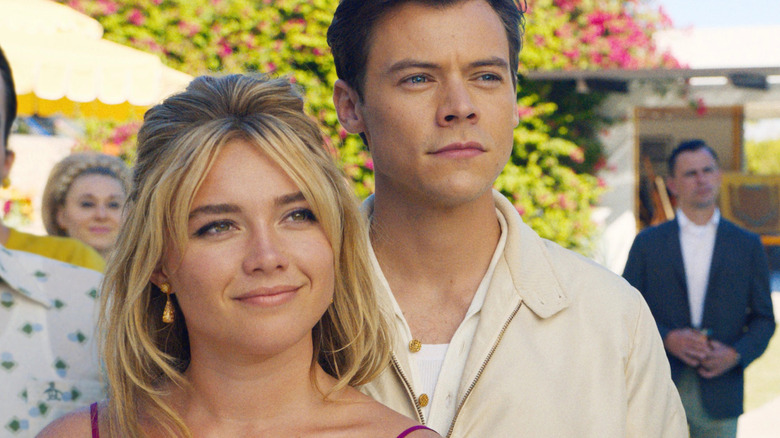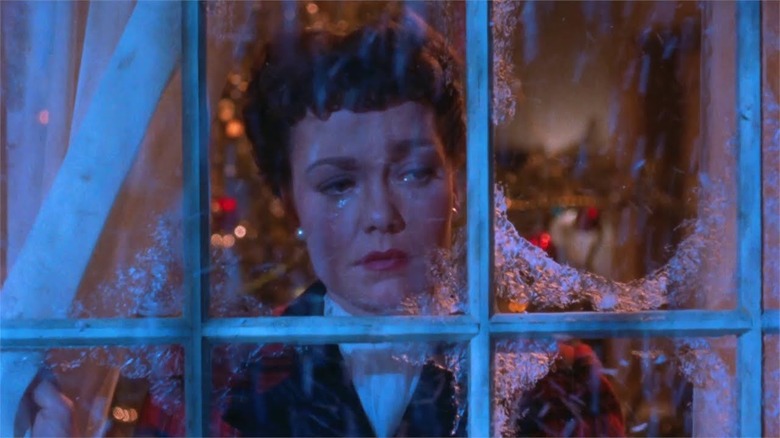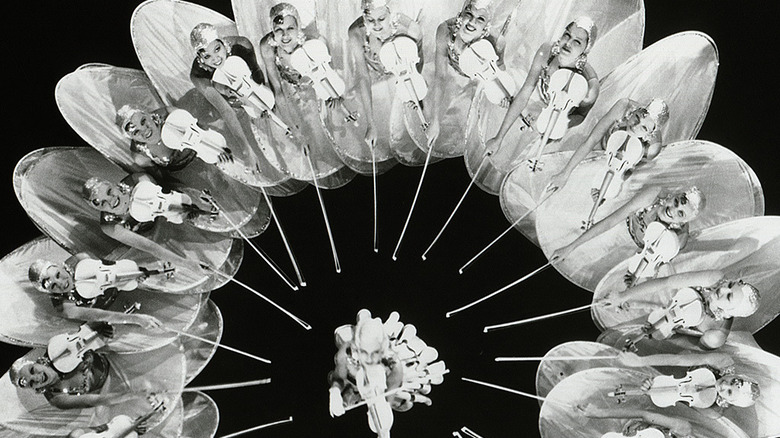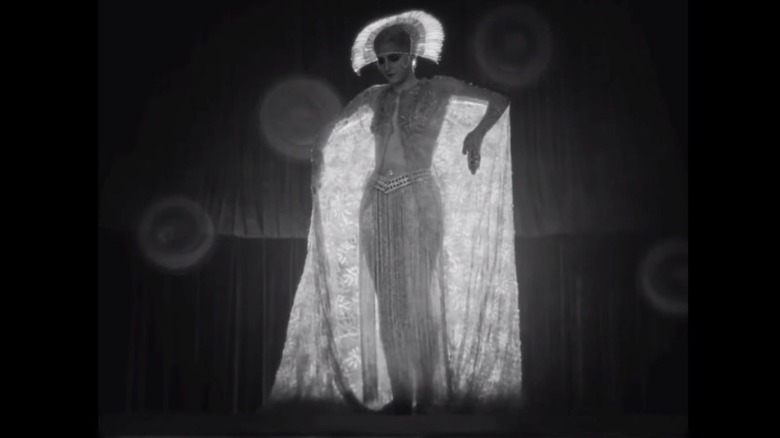Breaking Down The Classic Movies That Inspired Don't Worry Darling
This article contains major spoilers for "Don't Worry Darling."
The release of Olivia Wilde's "Don't Worry Darling" has been overshadowed by rumors of on-set affairs and rivalries, like something out of the gossip rags during the Golden Age of Hollywood. Florence Pugh carries the film as Alice, a 1950s housewife living with her husband played by a dead-eyed Harry Styles in the utopian desert community Victory. After the death and disappearance of her friend Margaret, she begins to worry that there is something sinister beneath her perfect and glamorous life.
The script unfolds in a puzzling twist that dulls the impact of its critique on gender roles. Wilde has a greater command over her mesmerizing visuals. Working with cinematographer Matthew Libatique (who photographed the visually similar "Black Swan"), "Don't Worry Darling" juxtaposes a slick suburban landscape with Alice's psychedelic hallucinations in images that seem inspired by many classic films.
Douglas Sirk melodramas
The glossy, well-manicured world of Victory with its palm trees and wide desert skies is not the same as the New England suburbs in a Douglas Sirk melodrama, but there is an uncanniness to the uniformity of these immaculate exteriors shot in bright colors. Both films portray environments that trap the female protagonist with its expectations of perfection.
In Sirk films, "Homes that are supposed to be havens start to look like prisons as the decor comes to dominate the compositions. Objects that are supposed to be items of support actually seem to be taking over the characters' lives" (via Senses of Cinema). We see this in "Don't Worry Darling" as Wilde's camera marvels the well-designed interior of Alice's home, the repetitive close-ups of her morning breakfast preparations or the neatly-lined rows of alcohol. Alice even tries to suffocate herself with the everyday object of plastic wrap.
Wilde borrows from Sirk when she frames Alice at home in overwhelming wide shots, as if the space she must meticulously care for every day is going to swallow her whole. "Don't Worry Darling" literalizes the idea of suburban oppression by having the walls close in and nearly crush Alice. The glass window functions as the prison-bar windows do in a Sirk film where a woman looks out at the beautiful nature she cannot be a part of.
Wilde also borrows from Sirk's overuse of mirrors where characters confront the false image they present to the world. Alice's image in front of multiple mirrors while she scrubs the tub every single day, as well as the eerie shot where her reflection moves the opposite of her body, symbolize her fractured mental state and how her perfect identity as a housewife is just an illusion.
Busby Berkeley dance numbers
Throughout "Don't Worry Darling," Alice's frequently sees Busby Berkeley style dance numbers reminiscent of "Gold Diggers of 1933." She envisions a circle of scantily dressed dancers with beaming smiles and perfectly synchronized body movements that make unique shapes and kaleidoscopic patterns shot from a bird's eye view — all the quintessential features of a Berkley number. Occasionally, these dancers transform into strange, demonic-like creatures.
These black and white interludes are not completely random. By the end of the film, we see that a video of the dancers is projected onto the ceiling where the real-world Alice is strapped to the bed against her will. It plays on a loop to keep Alice unconscious and transport her to the Victory simulation.
There's a deeper meaning to Wilde's Berkeley homage. The harmonious movements of Berkley's dancers echo the mantra of Alice's ballet class: "There is a beauty in control. There is a grace in symmetry. We move as one." BFI believes that Berkley numbers are unsettling and unusual because "the only other place you'll find such precise choreography en masse is in footage of the Nuremberg rallies, and it's no surprise that Joseph Goebbels was a huge Berkeley fan." They mirror Victory's ethos where women must remain in their regimented roles and not fall out of place. Uniformity and total submission to the community is valued in Victory, not individuality.
Fritz Lang's Metropolis
Wilde inserts trippy images of an eyeball into Alice's dreams, manipulating its shape and zooming in and out. By the end of "Don't Worry Darling," we understand that the shots refer to the twist ending where Alice and Jack are actually in the real world using a virtual reality device that holds their eyeballs open and flickers across them. The eyeball images can also be read as a nod to Fritz Lang's "Metropolis" which deals with similar themes as "Don't Worry Darling."
"Metropolis" shows a kaleidoscope shot of blinking eyes that belong to a group of men at a decadent nightclub. This is very similar to the party scene in "Don't Worry Darling" where the men celebrate their promotions. The affluent men in these films are hypnotized by ostentatious worlds that abuse the working class and women for their own gain. In "Metropolis," the men gaze at the robot Maria who performs a seductive dance for them, driving them into a chaotic frenzy. The back lights illuminate Maria in the same way that the glittering champagne dancer pulls the focus in "Don't Worry Darling." Harry Styles' puppet-like dancing is just as odd as Maria's, demonstrating his ability to blindly follow orders.
Wilde keeps intercutting to a hysterical Alice in the bathroom in the same way that Lang switches from the raucous party to the character of Freder having hallucinations about his beloved Maria who has been replicated as a robot. This rapid shifting from scene to scene heightens the tension. Both Freder and Alice want to expose the cruelty of society and destroy the systems that imprison them — the industrialized oppression of the working class in "Metropolis" and the patriarchy in "Don't Worry Darling."



